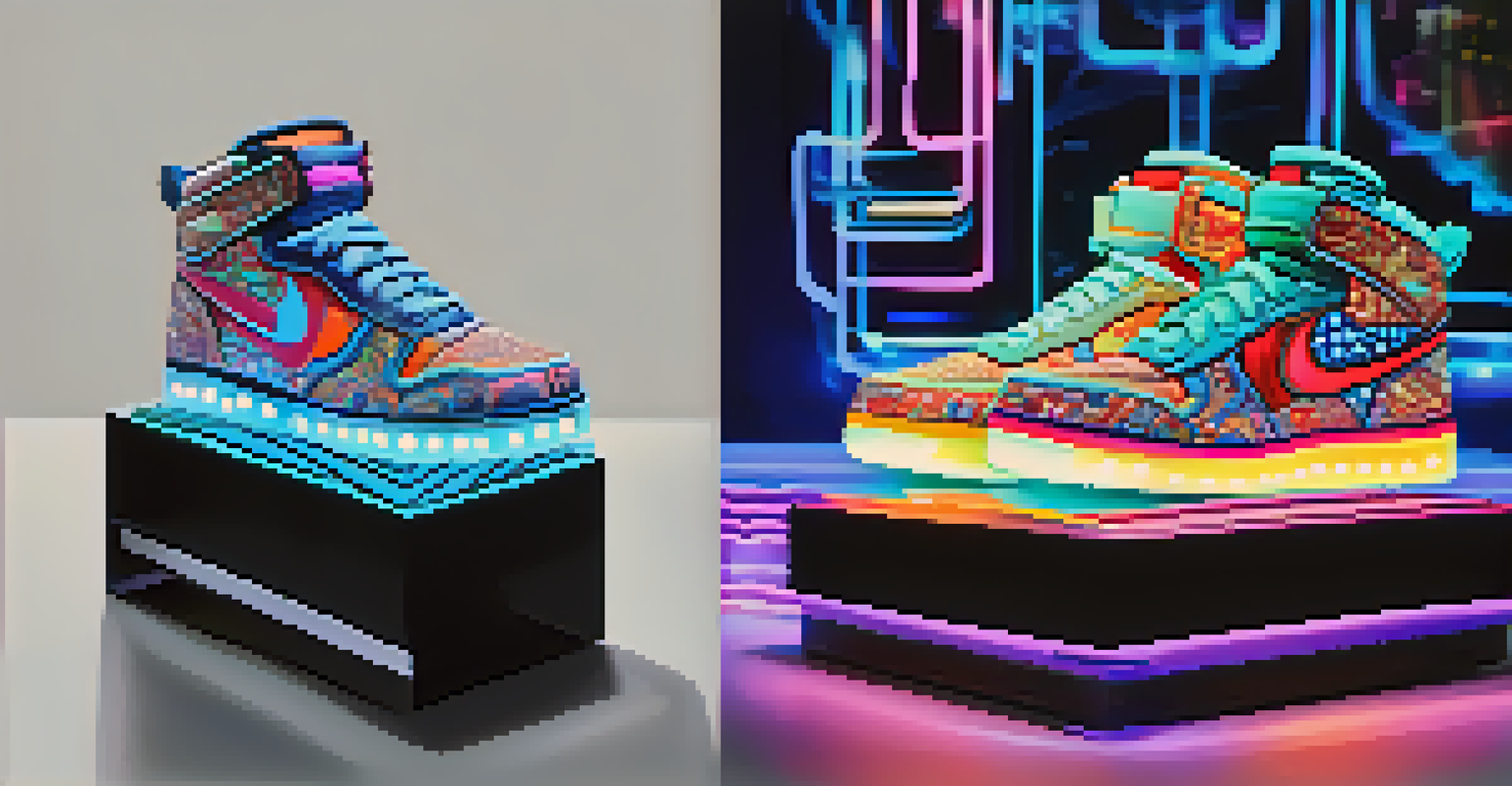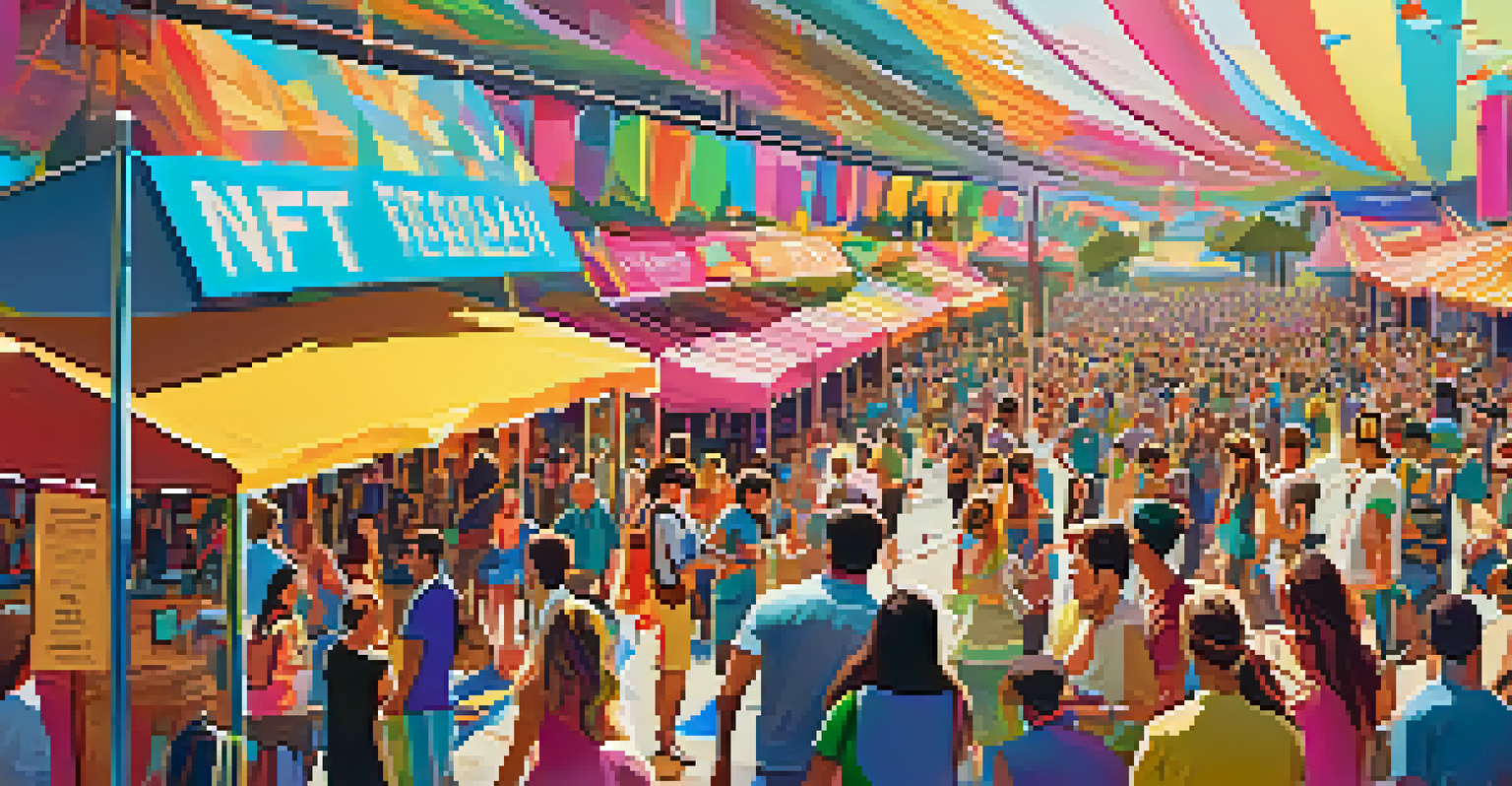Case Studies: Brands Successfully Using NFTs in Marketing

Understanding NFTs: A Quick Introduction for Marketers
NFTs, or Non-Fungible Tokens, are unique digital assets that represent ownership of a specific item, often linked to art, music, or collectibles. Unlike cryptocurrencies, which are interchangeable, each NFT has distinct information that makes it one-of-a-kind. This uniqueness is what makes NFTs appealing for brands looking to create exclusive marketing experiences.
NFTs are a new way to create value and engage with customers in a unique and meaningful way.
For marketers, NFTs offer a fresh avenue to engage customers in innovative ways. By tapping into the growing interest in digital collectibles and unique experiences, brands can foster deeper connections with their audience. This shift from traditional marketing methods to digital assets opens up exciting possibilities for creativity and brand storytelling.
As we delve into case studies of brands successfully using NFTs, keep in mind the potential of these digital tokens to not only enhance brand visibility but also to create a community around the brand. The following examples illustrate how various companies have harnessed the power of NFTs to elevate their marketing strategies.
Nike: Crafting Unique Digital Footwear Experiences
Nike has taken significant strides in the NFT space by launching digital sneakers that customers can own and trade. These virtual shoes not only celebrate the brand's heritage but also cater to the growing interest in digital fashion. By leveraging NFTs, Nike creates an exclusive community of collectors who are passionate about both fashion and technology.

In their 'Cryptokicks' initiative, Nike allows customers to purchase limited-edition sneakers as NFTs. Ownership of these digital assets comes with perks, such as early access to future releases and exclusive events. This strategy not only drives sales but also fosters a sense of loyalty among customers who appreciate being part of an elite group.
NFTs Redefine Brand Marketing
Brands are using NFTs to create unique digital experiences that foster deeper customer connections and loyalty.
By using NFTs, Nike is not just selling products; they are crafting experiences that resonate with their audience. This innovative approach keeps the brand at the forefront of both technology and fashion, ultimately enhancing customer engagement and brand loyalty.
Coca-Cola: Creating Collectible Moments with NFTs
Coca-Cola entered the NFT space by auctioning a series of unique digital collectibles that celebrated the brand's iconic moments. This initiative not only showcased their creativity but also highlighted the emotional connection they have with their consumers. The NFTs included digital artwork and exclusive experiences, making them highly sought after by collectors.
The future of marketing lies in the ability to tell compelling stories through digital assets.
Through this campaign, Coca-Cola demonstrated that NFTs can serve as a bridge between nostalgia and modern technology. They crafted a narrative around their brand by integrating storytelling with digital assets, allowing fans to own a piece of Coca-Cola history. This strategy not only generated buzz but also reinforced brand loyalty among existing customers.
Moreover, the proceeds from the NFT auction were donated to charity, which enhanced Coca-Cola's brand image as a socially responsible company. By engaging in the NFT space, Coca-Cola successfully created a unique marketing strategy that resonates with both collectors and fans.
Adidas: Building a Community with Digital Collectibles
Adidas has embraced NFTs as a way to build a community around its brand. Their 'Into the Metaverse' initiative allows customers to purchase virtual sneakers and apparel, fostering an interactive experience for fans. This move not only taps into the growing trend of digital ownership but also encourages customer participation in the brand's narrative.
By focusing on the community aspect, Adidas creates a sense of belonging among its customers. Owners of these NFTs gain access to exclusive events and collaborations, making them feel like they are part of something bigger. This strategy enhances customer engagement and encourages brand advocacy among fans who appreciate the unique experiences Adidas provides.
Community Building Through NFTs
Companies like Adidas and Nike leverage NFTs to cultivate a sense of community among customers, enhancing engagement and brand advocacy.
Through this approach, Adidas is redefining what it means to be a brand in the digital age. By combining fashion with technology, they are not only appealing to their existing customer base but also attracting a new audience interested in NFTs and the metaverse.
Ubisoft: Enhancing Gaming Experiences with NFTs
Ubisoft, a leading gaming company, has integrated NFTs into its games to provide players with unique in-game assets. These NFTs allow players to own, trade, and sell virtual items, giving them a sense of ownership that traditional gaming models lack. This innovative strategy enhances the gaming experience by making it more interactive and rewarding.
By utilizing NFTs, Ubisoft creates a vibrant marketplace within their games where players can showcase their unique assets. This not only increases player engagement but also generates additional revenue streams for the company. The ability to own and trade digital items adds a new layer of excitement and competition among players.
Ubisoft's approach to NFTs showcases how brands can leverage technology to enhance user experiences. By blending gaming and digital ownership, they are setting a precedent for how interactive entertainment can evolve in the future.
Beeple: Transforming Art into NFTs and Marketing Gold
Beeple, a digital artist, skyrocketed to fame when his NFT artwork sold for a staggering $69 million at auction. This landmark sale not only changed the art world but also highlighted the potential of NFTs in marketing. Beeple's success story serves as an inspiration for brands looking to explore the intersection of art and technology.
By creating limited-edition digital artworks, Beeple has tapped into the growing market for digital collectibles. His ability to merge art with storytelling has captivated audiences and brands alike, leading to collaborations that further amplify his reach. This demonstrates how artists can leverage NFTs as a marketing tool to gain visibility and recognition.
Innovative Strategies for Engagement
Successful case studies show that integrating NFTs allows brands to tap into new revenue streams while appealing to modern consumers.
Beeple's journey shows that NFTs can transform not just how art is created and consumed but also how brands can engage with their audience. By embracing this innovative format, brands can create unique marketing campaigns that resonate with consumers in today's digital landscape.
Topshop: Blending Fashion and Digital Collectibles
Topshop made headlines by launching a collection of NFTs that featured digital versions of their popular clothing items. This initiative not only appealed to fashion enthusiasts but also showcased the brand's commitment to innovation. By offering digital collectibles, Topshop tapped into a market that craves unique fashion experiences.
The NFTs allowed fans to purchase limited-edition virtual outfits, which they could showcase in various digital spaces. This blending of fashion and technology created buzz and excitement around the brand, attracting not only existing customers but also new audiences interested in digital fashion.

Through this strategic move, Topshop demonstrated that the future of fashion lies in the integration of digital assets. By embracing NFTs, they are paving the way for a new era of fashion marketing that fosters creativity and engagement among consumers.
Future Trends: NFTs and the Evolution of Marketing
As brands continue to explore the potential of NFTs, the future of marketing looks promisingly digital. The trend of using NFTs to create unique customer experiences is likely to grow, with more brands experimenting with this technology. This evolution signifies a shift in how brands connect with their audience, moving towards more personalized and engaging interactions.
Moreover, as consumer interest in digital ownership rises, brands that embrace NFTs early on will have a competitive edge. By integrating NFTs into their marketing strategies, companies can tap into new revenue streams while fostering customer loyalty through exclusive offerings.
In conclusion, the successful case studies we've explored highlight the transformative power of NFTs in marketing. As we look ahead, it's clear that the blend of creativity, technology, and consumer engagement will shape the future of brand marketing in the digital age.